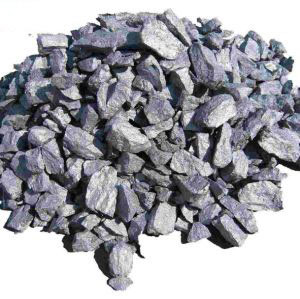
Adding magnesium and silica to iron melts in a cast iron foundry produces ductile castings of good machinability, strength and toughness. Magnesium ferro silicon alloys have been used for many years in production of ductile iron castings and are now being used in a wide range of other applications.
In-mold nodulizing of ductile iron is performed using an additive that crystallizes graphite from a molten metal into a nodular, spheroidal or granular form. This form minimizes the embrittlement effect of the graphite on the iron matrix and results in ductile castings with improved machinability, toughness and tensile properties.

Commercially available nodulizers comprise an additive that consists mainly of silicon and rare earth elements combined with silicides of iron, calcium and rare earth metals. The spheroidal form of the nodular graphite is more effective in producing the desired results than that produced by granular graphite.
The dissolution rate of a nodular iron alloy can be influenced by a number of factors. One is the concentration of magnesium in the iron poured in the mold, expressed as a ratio to the poured weight of iron. In order to obtain this magnesium concentration in the cast iron, the reaction chamber depth in which a particular type of nodular alloy is inserted must be matched to the pouring time of the metal and the total concentration of magnesium in the cast iron desired.
As the magnesium content in the nodular alloy increases, so does its rate of dissolution. This rate of dissolution can be determined by observation of the molten iron and a window in a test mold. Once the dissolution rate is determined, the cross-sectional area of the reaction chamber can be matched to the metal pouring time and a specific weight of the alloy can be chosen.
Typical percentages for the nodular alloy are 5 to 15% magnesium, 60 to 80% silicon, 0.1 to 1.5% calcium, 0.1 to 3.0% aluminum, and 0-2.5% rare earth. In addition to the nodularizing effect of the calcium and aluminum, the presence of these two metals also retards the rate at which the magnesium reacts with the liquid iron. This reduces the rate of slag formation and improves the recovery of magnesium in the iron.
A refractory alloy containing nodularizing elements may be plunged into a nominal 75% ferrosilicon alloy in order to produce the required nodular graphite iron casting. The refractory alloy is prepared by standard smelting techniques known in the metallurgical art.
It has been found that an alloy of this type will give a much faster dissolution than the previous types heretofore used commercially for in-mold nodulization of cast iron. For this reason, the dissolution rate can be adapted to a greater degree of tolerance than is possible with the alloys heretofore employed.
The optimum dissolution rate can be obtained by the alloy being mixed at a high level of magnesium with a small amount of silicon. The optimum amount of silicon depends upon the treatment method employed, the degree of reactivity and the economy of the addition rate. The optimum rate is usually between 7.5 and 9.5% of the total weight of the nodular alloy.

Write a Message